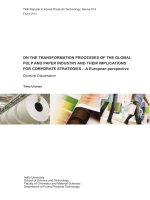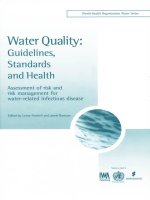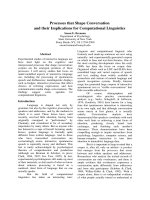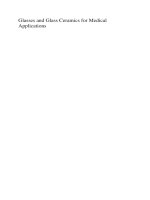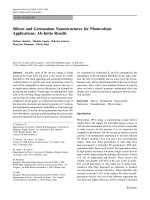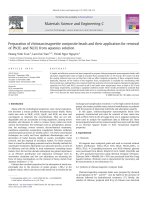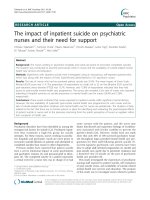ISO 25312009 Ductile iron pipes, fittings, accessories and their joints for water applications
Bạn đang xem bản rút gọn của tài liệu. Xem và tải ngay bản đầy đủ của tài liệu tại đây (546.46 KB, 78 trang )
INTERNATIONAL
STANDARD
ISO
2531
Sixth edition
2009-12-15
Ductile iron pipes, fittings, accessories
and their joints for water applications
Reference number
ISO 2531:2009(E)
© ISO 2009
ISO 2531:2009(E)
PDF disclaimer
This PDF file may contain embedded typefaces. In accordance with Adobe’s licensing policy, this file may be printed or viewed but
shall not be edited unless the typefaces which are embedded are licensed to and installed on the computer performing the editing. In
downloading this file, parties accept therein the responsibility of not infringing Adobe’s licensing policy. The ISO Central Secretariat
accepts no liability in this area.
Adobe is a trademark of Adobe Systems Incorporated.
Details of the software products used to create this PDF file can be found in the General Info relative to the file; the PDF-creation
parameters were optimized for printing. Every care has been taken to ensure that the file is suitable for use by ISO member bodies. In
the unlikely event that a problem relating to it is found, please inform the Central Secretariat at the address given below.
COPYRIGHT PROTECTED DOCUMENT
© ISO 2009
All rights reserved. Unless otherwise specified, no part of this publication may be reproduced or utilized in any form or by any means,
electronic or mechanical, including photocopying and microfilm, without permission in writing from either ISO at the address below or
ISO’s member body in the country of the requester.
ISO copyright office
Case postale 56 • CH-1211 Geneva 20
Tel. + 41 22 749 01 11
Fax + 41 22 749 09 47
Web www.iso.org
Published in Switzerland
ii
© ISO 2009 – All rights reserved
ISO 2531:2009(E)
Contents
Page
Foreword ............................................................................................................................................................iv
1
Scope ......................................................................................................................................................1
2
Normative references............................................................................................................................1
3
Terms and definitions ...........................................................................................................................2
4
4.1
4.2
4.3
4.4
4.5
4.6
Technical requirements ........................................................................................................................5
General ...................................................................................................................................................5
Pressure classification and dimensional requirements....................................................................7
Material characteristics.......................................................................................................................11
Coating and linings for pipes .............................................................................................................12
Coatings and linings for fittings and accessories ...........................................................................13
Marking .................................................................................................................................................13
5
5.1
5.2
5.3
Leaktightness requirements...............................................................................................................13
Pipes and fittings.................................................................................................................................13
Flexible joints.......................................................................................................................................13
Flanged joints as cast, screwed, welded and adjustable................................................................15
6
6.1
6.2
6.3
6.4
6.5
Test methods .......................................................................................................................................17
Dimensions ..........................................................................................................................................17
Straightness of pipes ..........................................................................................................................17
Tensile test ...........................................................................................................................................17
Brinell hardness ..................................................................................................................................19
Works leaktightness test of pipes and fittings.................................................................................20
7
7.1
7.2
7.3
7.4
Type tests .............................................................................................................................................20
Leaktightness of joints to internal pressure.....................................................................................20
Leaktightness of joints to external pressure....................................................................................21
Leaktightness of joints to negative internal pressure.....................................................................22
Leaktightness and mechanical resistance of flanged joints ..........................................................22
8
8.1
8.2
8.3
8.4
Tables of dimensions..........................................................................................................................23
Socket and spigot pipes .....................................................................................................................23
Flanged pipes ......................................................................................................................................25
Fittings for socketed joints.................................................................................................................25
Fittings for flanged joints ...................................................................................................................41
Annex A (informative) External protection .....................................................................................................59
Annex B (informative) Internal protection ......................................................................................................60
Annex C (informative) Dimensions of preferred pressure classes and other pressure class pipes .......61
Annex D (normative) Pipe wall thicknesses, stiffness and diametral deflection .......................................63
Annex E (normative) Quality assurance.........................................................................................................71
Annex F (informative) Safety factors ..............................................................................................................72
Bibliography......................................................................................................................................................73
© ISO 2009 – All rights reserved
iii
ISO 2531:2009(E)
Foreword
ISO (the International Organization for Standardization) is a worldwide federation of national standards bodies
(ISO member bodies). The work of preparing International Standards is normally carried out through ISO
technical committees. Each member body interested in a subject for which a technical committee has been
established has the right to be represented on that committee. International organizations, governmental and
non-governmental, in liaison with ISO, also take part in the work. ISO collaborates closely with the
International Electrotechnical Commission (IEC) on all matters of electrotechnical standardization.
International Standards are drafted in accordance with the rules given in the ISO/IEC Directives, Part 2.
The main task of technical committees is to prepare International Standards. Draft International Standards
adopted by the technical committees are circulated to the member bodies for voting. Publication as an
International Standard requires approval by at least 75 % of the member bodies casting a vote.
Attention is drawn to the possibility that some of the elements of this document may be the subject of patent
rights. ISO shall not be held responsible for identifying any or all such patent rights.
ISO 2531 was prepared by Technical Committee ISO/TC 5, Ferrous metal pipes and metallic fittings,
Subcommittee SC 2, Cast iron pipes, fittings and their joints.
This sixth edition cancels and replaces the fifth edition (ISO 2531:1998), of which it constitutes a technical
revision. A new classification system for pipes and fittings based on pressure is introduced with minimum wall
thickness determined by allowable operating pressure.
iv
© ISO 2009 – All rights reserved
INTERNATIONAL STANDARD
ISO 2531:2009(E)
Ductile iron pipes, fittings, accessories and their joints for
water applications
1
Scope
This International Standard specifies the requirements and test methods applicable to ductile iron pipes,
fittings, accessories and their joints for the construction of pipelines:
⎯
to convey water (e.g. for human consumption and raw water),
⎯
operated with or without pressure, and
⎯
installed below or above ground.
NOTE
In this International Standard, all pressures are relative pressures expressed in bar 1).
This International Standard specifies materials, dimensions and tolerances, mechanical properties and
standard coatings of pipes, fittings and accessories. It also gives performance requirements for all
components including joints.
This International Standard applies to pipes, fittings and accessories cast by any type of foundry process or
manufactured by fabrication of cast components, as well as corresponding joints in the size range DN 40 to
DN 2600 inclusive.
It is applicable to pipes, fittings and accessories which are
⎯
manufactured with socketed, flanged or spigot ends (joint design and gasket shapes are outside the
scope of this International Standard),
⎯
normally delivered internally and externally coated.
Pipes and fittings are classified according to allowable operating pressure.
2
Normative references
The following referenced documents are indispensable for the application of this document. For dated
references, only the edition cited applies. For undated references, the latest edition of the referenced
document (including any amendments) applies.
ISO 4016, Hexagon head bolts — Product grade C
ISO 4034, Hexagon nuts — Product grade C
ISO 4633, Rubber seals — Joint rings for water supply, drainage and sewerage pipelines — Specification for
materials
ISO 6506-1, Metallic materials — Brinell hardness test -– Part 1: Test method
ISO 7005-2, Metallic flanges — Part 2: Cast iron flanges
1)
100 kPa = 1 bar
© ISO 2009 – All rights reserved
1
ISO 2531:2009(E)
ISO 7091, Plain washers — Normal series — Product grade C
ISO 10803, Design method for ductile iron pipes
ISO 10804, Restrained joint systems for ductile iron pipelines — Design rules and type testing
EN 1092-2, Flanges and their joints — Circular flanges for pipes, valves, fittings and accessories, PN
designated — Part 2: Cast iron flanges
3
Terms and definitions
For the purposes of this document, the following terms and definitions apply.
3.1
accessory
any casting other than a pipe or fitting, which is used in a pipeline
EXAMPLE 1
Glands and bolts for mechanical flexible joints (see 3.18).
EXAMPLE 2
Glands, bolts and locking rings or segments for restrained joints (see 3.24).
NOTE
The term accessory is not relevant for valves or hydrants of any type.
3.2
allowable operating pressure
PFA
maximum internal pressure, excluding surge, which a component can safely withstand in permanent service
3.3
allowable site test pressure
PEA
maximum hydrostatic pressure that a newly installed component can withstand for a relatively short duration,
when either fixed above ground level or laid and backfilled underground, in order to measure the integrity and
tightness of the pipeline
NOTE
pipeline.
This test pressure is different from the system test pressure, which is related to the design pressure of the
3.4
batch
quantity of castings from which a sample may be taken for testing purposes during manufacture
3.5
component
any product defined as an element of a pipe, fitting or accessory
See 3.1, 3.9 and 3.22.
3.6
deviation
amount by which the design length may differ from the standardized length of a pipe or a fitting
NOTE
Pipes and fittings are designed to a length selected in the range of standard length plus or minus the deviation
(see Table 6); they are manufactured to this length plus or minus the tolerance given in Table 7.
3.7
diametral stiffness of a pipe
characteristic of a pipe allowing it to resist diametral deflection under loading
2
© ISO 2009 – All rights reserved
ISO 2531:2009(E)
3.8
ductile iron
type of cast iron used for pipes, fittings and accessories in which graphite is present primarily in spheroidal
form
3.9
fitting
casting other than a pipe, which allows pipeline deviation, change of direction or bore
NOTE
Flanged sockets, flanged spigots and collars are also classified as fittings.
3.10
flange
end of a pipe or fitting, extending perpendicular to its axis, with bolt holes equally spaced in a circle
NOTE
A flange can be fixed (e.g. integrally cast, screwed-on or welded-on) or adjustable. An adjustable flange
comprises a ring, in one or several parts bolted together, which bears on an end joint hub and which can be freely rotated
around the barrel axis before jointing.
3.11
flanged joint
joint between two flanged ends
3.12
flexible joint
joint providing significant angular deflection and movement parallel and/or perpendicular to the pipe axis
3.13
gasket
sealing component of a joint
3.14
hoop stress
σ
stress in a pipe or fitting under pressure, acting tangentially to the perimeter of a transverse section
3.15
joint
connection between the ends of pipes and/or fittings in which a gasket is used to effect a seal
3.16
laying length
Le
length by which a pipeline progresses when an additional pipe is installed
NOTE 1
For socket and spigot pipes, it is equal to the total length of the pipe, Ltot, minus the maximum spigot insertion
depth, Li, as given by the manufacturer and as shown in Figure 4. For flanged pipes, it is equal to the total length of the
pipe.
NOTE 2
It is expressed in metres.
3.17
maximum allowable operating pressure
PMA
maximum internal pressure, including surge, which a component can safely withstand in service
3.18
mechanical flexible joint
flexible joint in which sealing is obtained by applying pressure to the gasket by mechanical means
EXAMPLE
A gland.
© ISO 2009 – All rights reserved
3
ISO 2531:2009(E)
3.19
nominal pressure
PN
numerical designation, which is a convenient rounded number, used for reference purposes
NOTE 1
All components of the same nominal size, DN, designated by the same PN number have compatible mating
dimensions.
NOTE 2
Adapted from ISO 7268.
3.20
nominal size
DN
alphanumeric designation of size for components of a pipework system, which is used for reference purposes
NOTE 1
It comprises the letters DN followed by a dimensionless whole number, which is indirectly related to the
physical size, in millimetres, of the bore or outside diameter of the end connections.
NOTE 2
Adapted from ISO 6708:1995, definition 2.1.
3.21
ovality
out-of-roundness of a pipe section, equal to Equation (1)
100
( A1 − A2 )
( A1 + A2 )
(1)
where
A1 is the maximum axis, in millimetres;
A 2 is the minimum axis, in millimetres.
3.22
pipe
casting of uniform bore, with straight axis, having either socket, spigot or flanged ends
NOTE
This does not apply to flanged sockets, flanged spigots and collars, which are classified as fittings.
3.23
push-in flexible joint
flexible joint assembled by pushing the spigot through the gasket into the socket of the mating component
3.24
restrained joint
joint in which a means is provided to prevent separation of the assembled joint
3.25
socket
female end of a pipe or fitting to make the connection with the spigot of the next component
3.26
spigot
male end of a pipe or fitting
4
© ISO 2009 – All rights reserved
ISO 2531:2009(E)
3.27
spigot end
maximum insertion depth of the spigot, Li, plus 50 mm
See Li in Figure 4.
3.28
standardized length
length of pipe barrel and fitting body or branch as defined in this International Standard
NOTE 1
For socket and spigot pipes, and fittings, it is designated Lu (lu for branches). For flanged pipes, and fittings, it
is designated L (l for branches). See Figures 4 to 27.
NOTE 2
For flanged pipes and fittings, the standardized length L (l for branches) is equal to the total length. For
socketed pipes and fittings, the standardized length Lu (lu for branches) is equal to the total length minus the spigot
insertion depth, as indicated in the manufacturer’s catalogues.
3.29
type test
proof-of-design test, which is done once and is repeated only after change of design
4
Technical requirements
4.1
4.1.1
General
Pipes and fittings
Thicknesses, lengths and coatings are specified in this subclause, 4.2.3, 4.2.4 and 4.4 for pipes, and 4.5 for
fittings. When, by agreement between the manufacturer and the purchaser, pipes and fittings with different
lengths, thicknesses and/or coatings, and other types of fittings than those given in 8.3 and 8.4, are supplied
in accordance with this International Standard, they shall comply with all the other requirements of this
International Standard. This includes pipe and fittings manufactured to national standards and regulations.
The standard nominal sizes, DN, of pipes and fittings are the following:
40, 50, 60, 65, 80, 100, 125, 150, 200, 250, 300, 350, 400, 450, 500, 600, 700, 800, 900, 1000, 1100, 1200,
1400, 1500, 1600, 1800, 2000, 2200, 2400 and 2600.
The stiffness and allowable diametral deflection of ductile iron pipes are as given in Annex D.
NOTE
When installed and operated under the conditions for which they are designed (see Annexes A and B), ductile
iron pipes, fittings, accessories and their joints maintain all their functional characteristics over their operating life, due to
constant material properties, to the stability of their cross-section and to their design with high safety factors.
4.1.2
Surface condition and repairs
Pipes, fittings and accessories shall be free from defects and surface imperfections which could impair their
compliance with the requirements of Clauses 4 and 5.
When necessary, pipes and fittings may be repaired, for example by welding, to remove surface imperfections
and localized defects which do not affect the entire wall thickness, provided that the repaired pipes and fittings
comply with all the requirements of Clauses 4 and 5.
© ISO 2009 – All rights reserved
5
ISO 2531:2009(E)
4.1.3
4.1.3.1
Types of joints and interconnection
General
Joint design and gasket shapes are beyond the scope of this International Standard.
Rubber gasket materials shall conform to the requirements of ISO 4633 for water applications. When
materials other than rubber are necessary (e.g. high-temperature flanged joints), they shall conform to the
appropriate International Standards.
4.1.3.2
Flanged joints
Flanged joints shall be designed to facilitate attachment to flanges whose dimensions and tolerances comply
with ISO 7005-2 or EN 1092-2. This ensures interconnection between all flanged components (pipes, fittings,
valves, etc.) of the same DN and PN and adequate joint performance. Bolts and nuts shall comply, as a
minimum, with the requirements of ISO 4016 and ISO 4034, property class 4.6. Where washers are required,
they shall comply with ISO 7091.
In addition, each type of flange joint shall be designed to meet the performance requirements of 5.3.
Although it does not affect interconnection, the manufacturer shall indicate in his handbook whether his
products are normally delivered with fixed flanges or loose flanges.
4.1.3.3
Flexible joints
Pipes and fittings with flexible joints shall be in accordance with 4.2.2.1 for their spigot external diameters, DE,
and their tolerances. This provides the possibility of interconnection between components equipped with
different types of flexible joints. In addition, each type of flexible joint shall be designed to meet the
performance requirements of 5.2.
For interconnection with certain types of joints operating within a tighter tolerance range on DE, the
manufacturer’s guidance should be followed as to the means of ensuring adequate joint performance up to the
highest pressures (e.g. measurement and selection of external diameter).
For interconnection with existing pipelines which can have external diameters not in accordance with 4.2.2.1,
the manufacturer’s guidance should be followed as to the appropriate means of interconnection (e.g.
adaptors).
4.1.3.4
Restrained joints
Restrained joints for ductile iron pipelines shall be designed in accordance with ISO 10804. Their spigot
external diameters, DE, and their tolerances shall comply with 4.2.2.1.
4.1.4
Materials in contact with water intended for human consumption
When used under the conditions for which they are designed, in permanent or in temporary contact with water
intended for human consumption, ductile iron pipes, fittings and their joints shall not have detrimental effects
on the properties of that water for its intended use.
Ductile iron pipeline systems, including pipes, fittings, accessories and joints, consist of various materials.
When used for conveying water intended for human consumption, the materials in contact with the water shall
meet the relevant requirements of the national standards or regulations in the country of use with respect to
effect on water quality.
6
© ISO 2009 – All rights reserved
ISO 2531:2009(E)
4.2
Pressure classification and dimensional requirements
4.2.1
Pressure classifications
4.2.1.1
General
Components with flexible joints shall be classified by the allowable operating pressure (PFA) in bar, prefixed
by the letter C.
Components with flanged joints shall be classified by the PN number of the flange.
Allowable component pressure relationships shall be the following:
a)
Allowable operating pressure (PFA) = C, in bar
b)
Allowable maximum operating pressure (PMA) = 1,20 × PFA, in bar
c)
Allowable site test pressure (PEA) = (1,20 × PFA) + 5, in bar
The allowable pressures within a pipeline system shall be limited to the lowest pressure classification of all
components within the system.
4.2.1.2
Preferred pressure classes
Preferred pressure classes of components with flexible joints are C25, C30, and C40. Other pressure classes
are allowable, including C20, C50, C64 and C100.
Pressure classes for components with flanged joints are PN10, PN16, PN25 and PN40.
4.2.1.3
Allowable pressures
Allowable pressures of components are as given in Tables 1 and 2.
Table 1 — Allowable pressures of components with flexible joints for preferred classes
Pressure class
Allowable operating
pressure
Maximum allowable
operating pressure
Allowable site test
pressure
C
PFA
PMA
PEA
bar
bar
bar
25
25
30
35
30
30
36
41
40
40
48
53
Table 2 — Allowable pressures of components with flanged joints
Pressure class
Allowable operating
pressure
Maximum allowable
operating pressure
Allowable site test
pressure
PN
PFA
PMA
PEA
bar
bar
bar
10
10
12
17
16
16
20
25
25
25
30
35
40
40
48
53
© ISO 2009 – All rights reserved
7
ISO 2531:2009(E)
The allowable pressure for fittings as specified in Tables 15 to 33 are as follows:
⎯
socketed fittings, except tees, are given in Table 3;
⎯
socketed tees may be less than those given in Table 3 and shall be given in the manufacturer’s
handbook;
⎯
all flanged fittings and fittings with one flange, such as double-socketed tees with flanged branch, flanged
spigots and flanged sockets, are limited by the flange PN and are given in Table 2.
Table 3 — Allowable pressures for socketed fittings
Nominal size
Allowable operating
pressure
Maximum allowable
operating pressure
Allowable site test
pressure
DN
PFA
PMA
PEA
bar
bar
bar
40 to 200
64
77
82
250 to 350
50
60
65
400 to 600
40
48
53
700 to 1400
30
36
41
1500 to 2600
25
30
35
Appropriate limitations shall be taken into account, which can prevent the full range of these pressures being
used in an installed pipeline. For example, operation at the PFA values can be limited by the lower pressure
capability of other pipeline components, e.g. flanged pipework, certain types of tees and specific designs of
flexible joints. When other limitations exist due to the joint type or to any specific design arrangement, they
shall be given in the manufacturer’s handbook.
4.2.2
4.2.2.1
Diameter
External diameter
Table 14 gives the values of the external diameter, DE, of the spigot end of pipes and fittings, when measured
circumferentially using a circumferential tape as specified in 6.1.1. The positive tolerance is + 1 mm and
applies to all pressure classes of pipes and also to flanged spigot fittings.
The negative tolerance depends on the design of each type of joint and shall be as specified in national
standards, or, when not so specified, in manufacturers’ handbooks, for the type of joint and the nominal size
considered.
In addition, the ovality (see 3.21) of the spigot end of pipes and fittings shall
⎯
remain within the tolerances of DE for DN 40 to 200, and
⎯
not exceed 1 % of DE for DN 250 to DN 600 or 2 % for DN > DN 600.
The manufacturer’s recommendations should be followed with respect to the necessity and means of ovality
correction; certain types of flexible joints can accept the maximum ovality without the need for spigot
re-rounding prior to jointing.
4.2.2.2
Internal diameter
The nominal values of the internal diameters of centrifugally cast pipes, expressed in millimetres, are
approximately equal to the numbers indicating their nominal sizes, DN.
8
© ISO 2009 – All rights reserved
ISO 2531:2009(E)
4.2.3
Wall thickness
4.2.3.1
Pipes with flexible joints
The minimum wall thickness for pipes, emin, shall be not less than 3,0 mm and shall be determined using
Equation (2):
emin =
PFA × SF × DE
20Rm + (PFA × SF)
(2)
where
emin is the minimum pipe wall thickness, in millimetres;
PFA is the allowable operating pressure, in bar;
SF
is the safety factor for PFA (= 3);
DE
is the nominal pipe external diameter (see Table 14), in millimetres;
Rm
is the minimum tensile strength of ductile iron, in megapascals (Rm = 420 MPa; see Table 8).
NOTE
Equation (2) is derived from Barlow’s equation, i.e. hoop stress, σ = PD/2t (see 3.14)
For pipes centrifugally cast, the minimum wall thickness, emin, shall not be less than 3,0 mm. The nominal wall
thickness, enom, is equal to the minimum wall thickness, emin, plus (1,3 + 0,001 DN).
For pipes not centrifugally cast, the minimum wall thickness, emin, shall not be less than 4,7 mm. The nominal
wall thickness, enom, is equal to the minimum wall thickness, emin, plus (2,3 + 0,001 DN).
For centrifugally cast pipes, nominal pipe wall thicknesses for preferred ductile iron pressure classes are given
in Table 14. For other pressure classes, as given in Annex C, the user should confirm the availability with the
manufacturer.
4.2.3.2
Flanged pipes
Flanged pipe shall be classified by PN number. The pressure class of the barrel of the flanged pipes shall be
equal to or greater than a value in bar equal to the PN of the flanges. The pressure class of the flanged pipe
barrel to be used for fabricated flanged pipe shall be as indicated in 8.2 for welded-on flanges, screwed-on
flanges and integrally cast flanges.
NOTE
Pipe threads are regarded as loss of wall thickness.
4.2.3.3
Fittings
Nominal wall thicknesses, enom, are given for fittings in Tables 15 to 29, with allowable pressures given in
4.2.1.3. The minimum wall thickness, emin, for fittings is: emin = enom − (2,3 + 0,001 DN).
Fittings with other pressure classifications are allowed. The manufacturer shall be responsible for the design
of the fittings including the determination of wall thickness. The minimum wall thickness, emin, shall be not less
than 3,0 mm.
The design shall be carried out by a calculation method, e.g. finite element analysis, or an experimental
method, e.g. hydrostatic testing, using a safety factor of 3 against failure with respect to PFA.
© ISO 2009 – All rights reserved
9
ISO 2531:2009(E)
4.2.4
4.2.4.1
Length
Socket and spigot pipes
Pipes shall be supplied to the lengths given in Table 4.
Table 4 — Standardized lengths of socket and spigot pipe
Dimensions in metres
NOTE
a
DN
Standardized lengths, Lu a
40 and 50
3
60 to 600
4 or 5 or 5,5 or 6 or 9
700 and 800
4 or 5,5 or 6 or 7 or 9
900 to 2600
4 or 5 or 5,5 or 6 or 7 or 8,15 or 9
Not all the standardized lengths are available in all countries.
See 3.28.
The manufacturers’ design lengths, Lu (see 3.28), shall be within a deviation (see 3.6) of ± 250 mm with
respect to the lengths given in Table 4 and shall be given in their handbooks. The actual length, Lu, shall be
measured according to 6.1.3 and shall not differ from the manufacturer’s design length by more than the
tolerance given in Table 7. Of the total number of socket and spigot pipes to be supplied in each diameter, the
percentage of shorter pipes shall not exceed 10 %.
NOTE 1
Pipes cut for test purposes can be excluded from the 10 % limitation and treated as full-length pipes.
NOTE 2
When pipes are ordered on a meterage basis, the manufacturer can determine the required quantity of pipes
to be supplied by the summation of the measured individual pipe laying lengths.
4.2.4.2
Flanged pipes
The lengths of flanged pipes shall be as given in Table 5. Other lengths are available by agreement between
the manufacturer and the purchaser.
Table 5 — Standardized lengths of flanged pipe
Dimensions in metres
Type of pipe
DN
Standardized lengths, La
With cast-on flanges
40 to 2600
0,5 or 1 or 2 or 3 or 4
40 to 500
2 or 3 or 4 or 5
600 to 1000
2 or 3 or 4 or 5 or 6
1100 to 2600
4 or 5 or 6 or 7
With screwed-on or welded-on flanges
a
See 3.28.
4.2.4.3
Fittings
Fittings shall be supplied in the lengths given in 8.3 and 8.4 except that, alternatively, socket fittings may be
supplied in the lengths of the national standard of the country of manufacture.
NOTE
10
Two series of dimensions are shown, series A and series B, which is generally limited to DN 450 maximum.
© ISO 2009 – All rights reserved
ISO 2531:2009(E)
The permissible deviations (see 3.6) on the lengths of series A fittings shall be as given in Table 6.
Table 6 — Permissible deviations on length of fittings
Dimensions in millimetres
Type of fitting
DN
Deviation
Flanged sockets
40 to 1200
± 25
1400 to 2600
± 35
40 to 1200
+ 50
− 25
1400 to 2600
+ 75
− 35
Bends 90° (1/4)
40 to 2600
± (15 + 0,03) DN
Bends 45° (1/8)
40 to 2600
± (10 + 0,025) DN
Bends 22° 30' (1/16) and
11°15' (1/32)
40 to 1200
± (10 + 0,02) DN
1400 to 2600
± (10 + 0,025) DN
Flanged spigots
Collars, tapers
Tees
4.2.4.4
Tolerances on lengths
The tolerances on lengths shall be as given in Table 7.
Table 7 — Tolerances on length
Dimensions in millimetres
Type of casting
Tolerance
Socket and spigot pipes (full length or shortened)
−30
+70
Fittings for socketed joints
± 20
Pipes and fittings for flanged joints
± 10 a
a
By agreement between manufacturer and purchaser, smaller tolerances are possible, but not less than ± 3 mm for DN u 600 and
± 4 mm for DN > 600.
4.2.5
Straightness of pipes
Pipes shall be straight, with a maximum deviation of 0,125 % of their length.
The verification of this requirement is normally carried out by visual inspection, but in case of doubt or in
dispute, the deviation shall be measured in accordance with 6.2.
4.3
4.3.1
Material characteristics
Tensile properties
Pipes, fittings and accessories made of ductile iron shall have the tensile properties given in Table 8.
© ISO 2009 – All rights reserved
11
ISO 2531:2009(E)
During the manufacturing process the manufacturer shall carry out suitable tests to verify these tensile
properties; these tests may be either
a)
a batch sampling system whereby samples are obtained from the pipe spigot or, for fittings, from samples
cast separately or integrally with the casting concerned (test bars shall be machined from these samples
and tensile tested according to 6.3), or
b)
a system of process control testing (e.g. non-destructive), by which a positive correlation can be
demonstrated with the tensile properties specified in Table 8; testing verification procedures shall be
based on the use of comparitor samples having known and verifiable properties; this system of testing
shall be supported by tensile testing in accordance with 6.3.
Table 8 — Tensile properties
Type of casting
Minimum tensile strength,
Rm
Minimum percent elongation after fracture,
A
MPa
%
DN 40 to DN 2600
DN 40 to DN 1000
DN 1100 to DN 2600
Pipes centrifugally cast
420
10
7
Pipes not centrifugally cast,
fittings and accessories
420
5
5
By agreement between the manufacturer and the purchaser, the 0,2 % proof stress, Rp02, may be measured. It shall be
not less than: 270 MPa when A W 12 % for DN 40 to DN 1000 or when A W 10 % for DN > 1000; 300 MPa in other cases.
For centrifugally cast pipes of DN 40 to DN 1000 having a design minimum wall thickness of 10 mm or greater, the
minimum elongation after fracture shall be 7 %.
4.3.2
Brinell hardness
The hardness of the various components shall be such that they can be cut, tapped, drilled and/or machined
with standard tools. In case of dispute, the hardness shall be measured according to 6.4.
The Brinell hardness shall not exceed 230 HBW for centrifugally cast pipes and 250 HBW for non-centrifugally
cast pipes, fittings and accessories. For components manufactured by welding, a higher Brinell hardness is
allowed in the heat-affected zone of the weld.
4.4
Coating and linings for pipes
Pipes shall normally be delivered internally and externally coated.
4.4.1
External coatings
Ductile iron pipeline systems can be installed in a wide range of external operating environments. These
environments can be characterized according to their aggressivity. For relevant factors, see A.1.
Coatings specified by relevant International Standards are available as specified in A.2. Other coatings are
available.
4.4.2
Internal linings
Ductile iron pipeline systems can be used to convey a wide range of raw waters and potable waters. These
internal environments can be characterized by their aggressivity. Relevant factors to be considered for cement
mortar linings without seal coats are given in B.1.
Linings specified by relevant International Standards are available as specified in B.2. Other linings are also
available.
12
© ISO 2009 – All rights reserved
ISO 2531:2009(E)
4.5
Coatings and linings for fittings and accessories
Fittings and accessories shall normally be delivered internally and externally coated.
4.5.1
External coatings
Ductile iron pipeline systems can be installed in a wide range of external operating environments. These
environments can be characterized by their aggressivity. For relevant factors, see A.1.
Coatings specified by relevant International Standards are available as specified in A.3. Other coatings are
also available.
4.5.2
Internal linings
Ductile iron pipeline systems can be used to convey a wide range of raw waters and potable waters. These
internal environments can be characterized according to their aggressivity. Relevant factors to be considered
for cement mortar linings without seal coats are given in B.1.
Linings specified by relevant International Standards are available as specified in B.3. Other linings are also
available.
4.6
Marking
All pipes and fittings shall be durably and legibly marked and shall bear at least the following indications:
a)
a reference to this International Standard, i.e. ISO 2531;
b)
the manufacturer’s name or mark;
c)
identification of the year of manufacture;
d)
identification as ductile iron;
e)
the DN;
f)
the PN rating of flanges, if applicable;
g)
the C pressure class of socket and spigot pipe.
Items b) to f) shall be cast-on or cold stamped. Items a) and g) can be applied by any method, e.g. painted on
the castings.
5
Leaktightness requirements
5.1
Pipes and fittings
Pipes and fittings shall be designed to be leaktight at their allowable site test pressure (PEA). They shall be
tested according to 6.5 and shall exhibit no visible leakage, sweating or any other sign of failure.
5.2
5.2.1
Flexible joints
General
All flexible joints for ductile iron pipes and components shall be designed in compliance with the requirements
of 5.2. If the design has been tested and documented by the manufacturer and successfully used for a
minimum of 10 years, the performance of a type test as specified in 5.2.2 for internal pressure, as specified
© ISO 2009 – All rights reserved
13
ISO 2531:2009(E)
in 5.2.3 for external pressure and as specified in 5.2.4 for negative internal pressure, is only required for
significant changes in design which could adversely affect the performance of the joint.
Joint designs shall be type tested to demonstrate leaktightness to both internal and external pressure under
the most unfavourable conditions of castings tolerances and joint movements.
There shall be a type test for at least one DN for each of the groupings given in Table 9. One DN is
representative of a grouping when the performances are based on the same design parameters throughout
the size range.
Table 9 — DN groupings for type tests
DN groupings
40 to 250
300 to 600
700 to 1000
1100 to 2000
2200 to 2600
Preferred DN in each grouping
200
400
800
1600
2400
If a grouping covers products of different designs and/or manufactured by different processes, the grouping
shall be sub-divided.
If, for a manufacturer, a grouping contains only one DN or PN, this DN or PN may be considered as part of the
adjacent grouping provided that it is of identical design and manufactured by the same process.
The type tests shall be carried out in the configuration of maximum design radial gap between the
components to be jointed (smallest spigot together with largest socket).
In the type test, the maximum gap shall be equal to the maximum design radial gap with a tolerance of − 50 %.
The internal socket diameter may be machined to achieve this, even if the resulting diameter is slightly outside
the normal manufacturing tolerance.
All joints shall be performance tested with a spigot having an average iron wall thickness (over a distance
of 2 DN, in millimetres, from the spigot face) equal to the specified minimum value for the pipe for which the
joint is designed, + 10
0 %. It is permissible to machine the spigot of the pipe bore to achieve the required
thickness.
Restrained flexible joints shall be designed and tested in accordance with ISO 10804.
5.2.2
Internal pressure
The leaktightness of joints to internal pressure shall be type tested as specified in 7.1 at a test pressure of
1,5PFA + 5 bar; the joints shall exhibit no visible leakage in the two following positions:
a)
joint aligned and subjected to shear; the shear force across the joint, expressed in N, shall not be less
than 30 times DN;
b)
joint deflected; the test angular deflection shall be the maximum allowable deflection indicated in the
manufacturer's handbook, but not less than 3° 30' for DN 40 to DN 300, 2° 30' for DN 350 to DN 600,
1° 30' for DN 700 to DN 2600. These minimum deflections do not apply to restrained joint pipe.
5.2.3
External pressure
The leaktightness of joints to external pressure shall be type tested as specified in 7.2; the joints shall exhibit
no visible leakage when subjected to a shear load, expressed in newtons, not less than 30 times DN.
The test pressure shall be not less than 2 bar.
14
© ISO 2009 – All rights reserved
ISO 2531:2009(E)
5.2.4
Negative internal pressure
The leaktightness of joints to negative internal pressure shall be type tested as specified in 7.3 at a test
pressure of 0,9 bar below atmospheric pressure (approximately 0,1 bar absolute pressure). The maximum
pressure change during the test period shall not be more than 0,09 bar after 2 h, when tested in the following
two positions:
a)
joint aligned and subjected to shear; the shear force across the joint, expressed in N, shall not be less
than 30 times DN;
b)
joint deflected; the test angular deflection shall be the maximum allowable deflection indicated in the
manufacturer’s handbook, but not less than 3° 30' for DN 40 to DN 300, 2° 30' for DN 350 to DN 600,
1° 30' for DN 700 to DN 2600. These minimum deflections do not apply to restrained joint pipe.
5.3
Flanged joints as cast, screwed, welded and adjustable
5.3.1
General
All flanged joints for ductile iron pipes and components shall be designed in compliance with the requirements
of 5.3. If the design has been tested and documented by the manufacturer and successfully used for a
minimum of 10 years, the performance of a type test as specified in 5.3.2 is only required for significant
changes in design which could adversely affect the performance of the joint.
When flanges are involved, there shall be a type test for at least one DN for each of the groupings given in
Table 9. The PN to be tested is the highest PN existing for each flange design. One PN is representative of a
grouping when the performances are based on the same design parameters throughout the size range.
If a grouping covers products of different designs and/or manufactured by different processes, the grouping
shall be sub-divided.
If, for a manufacturer, a grouping contains only one DN or PN, this DN or PN may be considered as part of the
adjacent grouping provided that it is of identical design and manufactured by the same process.
5.3.2
Internal pressure and bending moment
In order to demonstrate their strength and leaktightness in service conditions, flanged joints shall be subjected
to a type test. When tested as specified in 7.4, they shall show no visible leakage under the combined effects
of a hydrostatic internal pressure and a bending moment as given in Table 10, where
⎯
the pressure is (1,5PN + 5) bar,
⎯
the relevant bending moment is obtained by addition of the bending moments due to the weight of the
components and of the water in the test assembly and those due to a possible external load calculated as
a function of the length of the unsupported span of the testing arrangement (see 7.4).
A type test shall be carried out on each type of flange joint available from the manufacturer in accordance with
Table 10.
The bending moments given in Table 10 are approximately equal to those resulting from the weight of the
preferred classes of pipes (utilizing the nominal thicknesses), of the cement mortar lining, and of the water
over an unsupported pipe length, L, between simple supports, with, for welded, integrally cast and adjustable
flanged joints,
⎯
L = 8 m for DN u 250,
⎯
L = 12 m for DN W 300;
© ISO 2009 – All rights reserved
15
ISO 2531:2009(E)
and for screwed flanged joints,
⎯
L = 6,8 m for DN u 800,
⎯
L = 10 m for DN W 900.
Table 10 — Bending moments for flange joint type tests of preferred classes of pipes
Integrally cast, welded
and adjustable
Screwed
kN·m
kN·m
40
0,6
0,4
50
0,7
0,6
60
0,9
0,7
65
1,0
0,8
80
1,3
1,0
100
1,7
1,4
125
2,4
2,0
150
3,1
2,7
200
4,8
4,5
250
7,1
6,7
300
22,1
9,3
350
29,1
12,6
400
36
16
450
45
20
500
54
25
600
77
35
700
100
47
800
129
52
900
161
140
1000
197
159
1100
237
192
1200
281
214
1400
383
274
1500
437
314
1600
495
355
1800
623
447
2000
766
549
2200
928
644
2400
1 100
764
2600
1 287
894
DN
16
© ISO 2009 – All rights reserved


